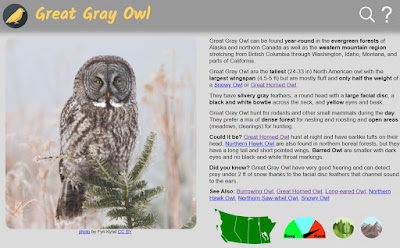- The circle of feathers surrounding many owls’ faces acts like a satellite dish, helping to collect the sound waves and channel them to their ears. In addition, their ears are often located at different heights on their head helping them to pinpoint where a sound originates.
- Owls’ eyes function like a pair of binoculars. They are cylindrical and immobile, which increases depth perception and helps them to focus on their prey.
- Owls can swivel their heads up to 270 degrees, giving them an amazing opportunity to see in all directions while remaining almost motionless.
Owls swallow their prey whole, digesting what they can and storing the indigestible parts – teeth, bones, claws, feathers, and fur – in the second part of their stomach, the gizzard. The undigested parts are compressed into a pellet the shape of the gizzard and regurgitated several hours after they finish eating. By examining an owl pellet, you can discover what they have been eating.
Owls use their feet to grab their prey. The bones are shorter and stronger than in other birds, helping them to withstand the shock when they make contact with their victim. The bottom of their feet has a rough, knobbly surface that improves their grip and helps them to hang on to the animal they have captured. Like other raptors, owls have 3 toes facing forward and one facing back. But owls are able to rotate one of their forward-facing toes to the back, giving them a better, more even grip on their prey as it struggles to escape.
If a Canada Goose flies overhead, you can clearly hear its wings flapping. But that’s not the case with owls, particularly those that hunt at night. Their large wings (Snowy Owl have a wingspan of 4-5 feet) enable them to fly as slowly as 2 miles per hour with little flapping. A comb-like fringe on the wing feathers creates smaller streams of air, helping to muffle the sound of the air rushing over their wings. Silent flight means that their prey don’t hear them coming and the owls’ hearing isn’t masked by the sound of their own wings.
Not all owls hunt by night. Some only hunt by night; others only hunt by day; while many are active both day and night. Northern Hawk Owl hunt by day, relying on their eyesight more than their hearing. Birds that usually hunt at night, such as the Great Horned Owl, are often after rodents, which are more active at night.
See also: Owls of Saskatchewan
Find out more about Saskatchewan wildlife on EcoFriendly Sask’s Nature Companion


